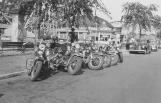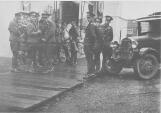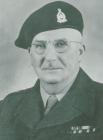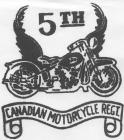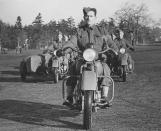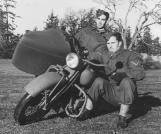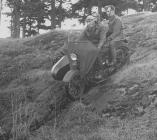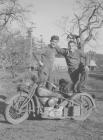1
04) 9th Armoured in WW II 1939 - 1945- Declaration
- Prince George Detachment
- 5th Canadian Motorcycle Corps
- 9th Canadian Armoured Regiment (BC Dragoons) CASF
- England
- BCDs go to Italy
- Hitler Line
- Gothic Line
- Northwest Europe
- Victory and Repatriation
3
The Regiment spent the winter of 1939-1940 training, and waiting for orders to mobilize. Proof that the nation was truly at war was brought home in late 1939 when elements of the Regiment under Capt. Harry H. Angle were detailed to guard rail lines and bridges in the Prince George area against sabotage.The annual camp at Vernon in May 1940 saw the Regiment train for the first time without horses. The successes of Hitler's armour in Poland, and more recently in Western Europe, finally put an end to the view that men on horseback could fight effectively against tanks and machine guns. Of course, the Regiment had no tanks or armoured cars with which to train; but they made do with trucks and cars rented from local garages, which were used to simulate armoured vehicles, while saw-horses doubled for motorcycles.
As spring of 1940 advanced into summer, many of the men left to join other units, such as the Seaforth Highlanders of Canada or the British Columbia Regiment, in the hope of going overseas quicker. For those who remained, the waiting ended in July 1940 when word was received that a new regiment would be organized and mobilized out of the militia unit, to be called the 5th Canadian Motorcycle Regiment (BCD). As with the 30th BCH and the 2nd CMRs in WW I, a new active service force was to be created in addition to the existing militia unit, from which many recruits would be drawn. The new regiment would have an establishment of 450 all ranks, with a Headquarters, and three fighting squadrons. The militia unit, the BC Dragoons, would continue in the Okanagan as an armoured car regiment.
The 5th Canadian Motorcycle Regiment (5th CMC) immediately concentrated in Vernon. Enthusiasm was high, but again there was no equipment for training. Much of the early fall of 1940 was spent rendering the men physically fit.
In October 1940 the Regiment was sent to southern Vancouver Island, one squadron (Sqn) to Duncan, the balance to Esquimalt. During the winter of 1940-1941, the Regiment received its motorcycles and the men became quite proficient in their use on the Island roads and countryside, to the occasional terror of the local population.
13
Some fine examples of civilian Harley Davidsons at an amusement park.1940
Probably Victoria, BC, Canada
